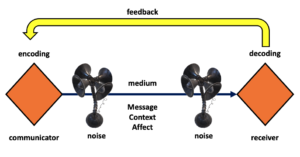Effective Mentoring Techniques
Verbal Mentoring Techniques
It is not surprising that one of the top skills employers are searching for in hiring new people is their ability to communicate clearly and effectively with others. Acquiring good communication skills is imperative to co-ordinating work schedules and duties, resolving conflicts, and ensuring people stay safe on the job site.
We may not realize what is happening when we are engaged in a conversation with someone, but there is a process of communication. The following figure illustrates the process;

Encoding
Encoding is the process of turning thoughts into communication. The encoder uses a ‘medium’ to send the message — a phone call, email, text message, face-to-face meeting, or other communication tools. The level of conscious thought that goes into encoding messages may vary. The encoder should also take into account any ‘noise’ that might interfere with their messages, such as other messages, distractions, or influences.
Decoding
Your apprentice then ‘decodes’, or interprets, the message for themselves. Decoding is the process of turning communication into thoughts. For example, you may realize you are running low on materials and encode the following message to send to your apprentice: “We need some more materials. Can you run down to the material trailer and grab some more?” As your apprentice receives the message, they decode your communication and turn it back into thoughts to make meaning.
Feedback
When your apprentice responds to your question, intentionally or unintentionally, that apprentice is providing feedback. Feedback is composed of messages the receiver sends back to the one communicating. Verbal or nonverbal, feedback signals allow the source to see how well, how accurately (or how poorly and inaccurately) the message was received.
Medium, Message, Context
The medium is the channel or the way a message (or group of messages) travels between the communicator and the receiver(s). Mediums would include face to face conversations, phone calls and messages, text messages, direct messaging, purchase orders, requests for information, emails, blogs, podcasts, tweets.
The message brings together words to convey meaning. Although the communication process also includes how those messages are conveyed. For example, when you are communicating to your supervisor, roughly eighty to ninety (80%-90%) is non-verbal and only ten percent (10%) are actual words. It is also important to note that bias (what a person thinks) has an effect on the words chosen (coded) for the message as well as how the message is received (decoded).
This is referred to as context. The context of the communication process includes such things as location, people involved, the content of the message, and expectations of the communicator and the receiver. The context may also include environmental cues such as clothing, the number of people involved in the communication, and specific trades language (nuance or lingo).
Noise
Noise, also referred to as interference, can come from any source. Noise is anything that blocks or changes the communicator’s intended meaning of the message being conveyed. This can include actual external noise from machinery and tools but also could range from the internal noise (bias) of the receiver to the communicator’s or receiver’s emotions and feeling in a particular given moment of the day. Essentially, noise interferes with normal encoding and decoding of the message carried by the medium between communicator and receiver.
Bad Communication in the Workplace

